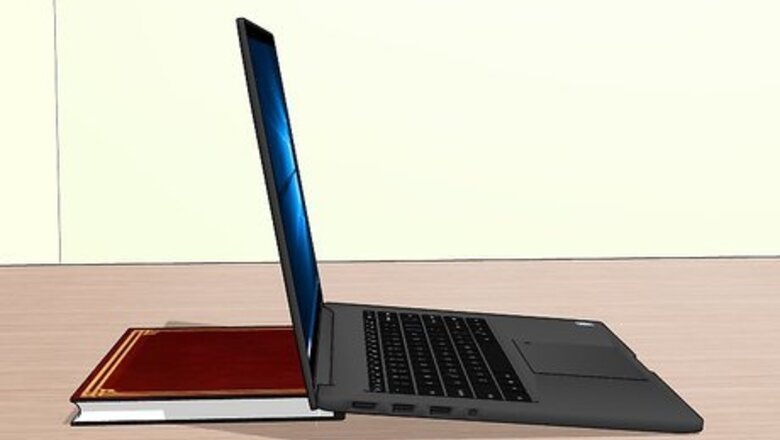
views
- Place your laptop on a box or stack of books so it's at eye level. Then, pair your device with an external mouse and keyboard for a more ergonomic design.
- Make a DIY laptop desk stand out of cardboard or place your laptop on top of a pizza box.
- Invest in a laptop desk stand to ensure you’re getting the most ergonomic experience, especially if you spend long periods of time on your computer.
DIY Solutions

Slide a book behind the back of the laptop to improve its angle. Make your laptop more ergonomic by taking a long, solid book and sliding the spine underneath the back of the laptop. Continue sliding the book toward the front of the laptop until the laptop screen is elevated around a 1–3 inches (2.5–7.6 cm) angle and easier for you to look at. If you slide the book too far forward, your laptop may slide off. Try putting a heavier book in front of the laptop to hold it in place. If you have pads on the bottom of the laptop to protect the surface underneath, put the spine just in front of these pads so the computer catches on the lip of the book. If you don’t have a book nearby, try using other objects, like wine corks, lids, wood objects, or plastic cases.
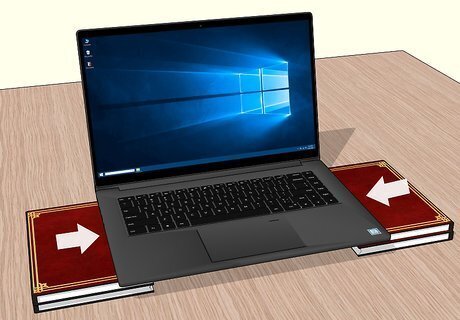
Prop the laptop up with books along the sides. Grab a stack of 2-4 books that are equally thick. Slide the spine of a book 2–3 inches (5.1–7.6 cm) under the laptop’s right side, then do the same on the left side. If you want to stabilize the laptop further, slide another book under the back or the front of the laptop. This creates some space between the bottom of the laptop and the surface it’s resting on. This space makes it easier for heat to dissipate from the laptop’s base when it gets hot. You can do this with a stack of any stable objects that are equally thick. For example, you could use stacks of coasters, hard plastic cases, Legos, board game boxes, or pieces of wood. For a cleaner look, cut 6-10 wine corks in half and set them under the laptop with the flat sides facing down.
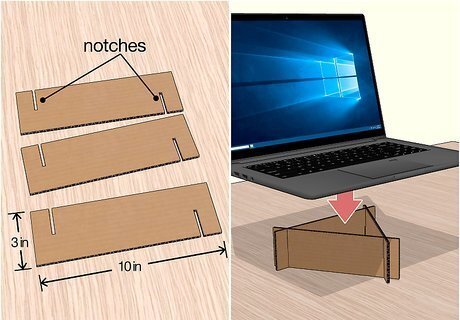
Build a small platform out of corrugated cardboard. Grab a sheet of corrugated cardboard and cut it into 3 strips that are roughly 2–3 inches (5.1–7.6 cm) thick and 8–10 inches (20–25 cm) long. Either glue or staple the pieces together in a triangle. Set the laptop on top of the triangle. Unless your laptop is really big or heavy, it should rest on top of the cardboard just fine. Alternatively, use a 10–12 in (25–30 cm) unused pizza box and set the laptop on top of the box with the corners sticking out of the sides.
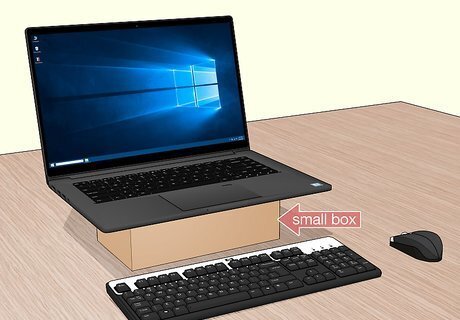
Set the laptop on a taller object and use a second keyboard and mouse. If you want to elevate the laptop to avoid neck strain, set it down on top of a small box, platform, stack of books, or shelf that rests at eye level. Then, plug in or pair an external keyboard and mouse to the laptop. You can control the laptop from the table or desk underneath while looking ahead at the screen.Variation: You can also do this with an external monitor if you want a second screen. Plug an HDMI cable into the laptop and connect it to a second monitor. Put the second screen on the platform and the laptop on the other side of the table.
Best Laptop Stands
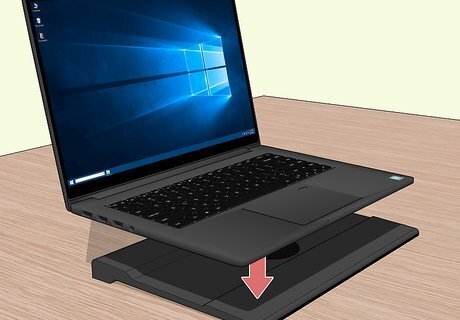
Get a cooling stand with a built-in fan to keep your laptop cool. If you’re having trouble with your laptop overheating, buy a laptop stand with a built-in fan or cooling pad. Set the laptop on top of the stand and plug the fan into an outlet or USB port to turn it on. The fan or cooling pad will activate and keep the heat from building up in your laptop. Some of these stands run on batteries and have a power button, usually on the side of the base. Desk laptop stands cost roughly $10-50 depending on the features and brand.
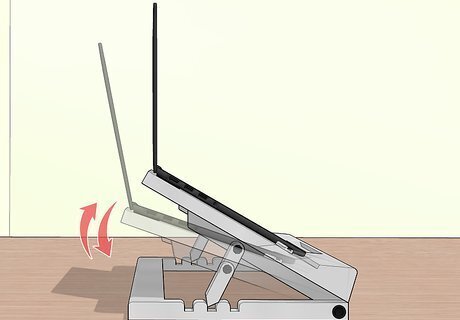
Invest in an adjustable laptop stand to control the angle and height. If you want more control over the height and angle of the laptop, get an adjustable desk stand. Before putting your laptop on the stand, use the knob or lever to adjust the angle and height. Then, set your laptop on top of the platform so that the base catches on the lip at the bottom of the platform. Some adjustable stands are known for being less stable than non-adjustable versions. Look at reviews and inspect the product in person (if you can) to get a better sense of how stable the stand is.

Use a standing platform as a DIY standing desk. If you want to customize the height of your laptop, opt for a standing platform stand. These stands are like small desks with legs that raise or lower that can be placed on the ground or top of your desk. Some of them also allow you to change the laptop’s angle. This makes them a great option if you like to occasionally stand while you’re using your laptop. These standing platforms are often marketed as adjustable “mini-desks.” Standing platforms are the most expensive option, costing anywhere from $20-300, depending on the style and options you want.
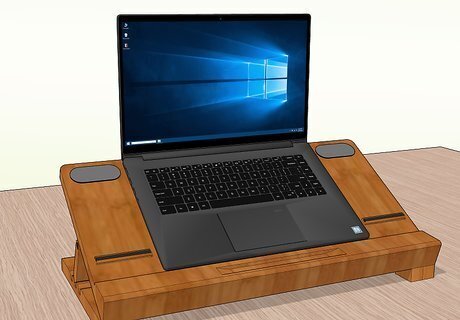
Purchase a wood laptop stand for a sleeker, cleaner look. If you care about how your laptop stand looks on your desk, invest in a stand with a wood stand with a grain and color that matches the rest of the room. Simply place the laptop on top, with the laptop’s bottom resting against the bottom lip of the stand.Tip: Wood doesn’t retain heat as well as plastic or metal, which is what laptop stands are usually made out of. This makes wood stands a good option if you encounter minor heat issues when you’re playing games or streaming video.
How do you make a laptop ergonomic?}
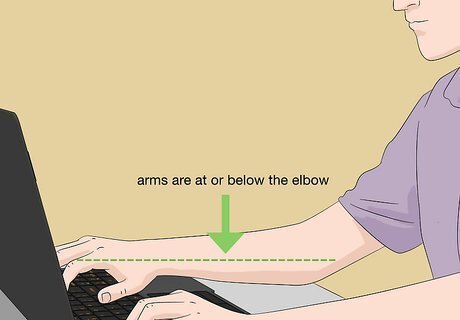
Make a laptop ergonomic by keeping the monitor an arm’s length away and ensuring your arms are at or below your elbows. An ergonomic laptop or desk setup can help reduce neck, back, wrist, and shoulder pain all while improving efficiency. Whether you’re using a DIY solution or a prebuilt desk stand, it’s important that your laptop is positioned a certain way, especially if you spend long periods of time on it. Here are some basic guidelines you can follow to make your laptop more ergonomic: Adjust the height of your chair so your feet rest flat on the floor. Alternatively, you can use a footrest to ensure your feet are parallel to the floor. Place the keyboard in front of you so your wrists and forearms align with your shoulders. Set up your monitor straight in front of you, slightly below eye level, about an arm’s length away from your face. Consider using an external keyboard and mouse if your laptop has a touchpad to help keep your wrists straight. Opt for larger, higher-resolution screens and monitors to reduce eye strain and the need to lean forward.
















Comments
0 comment